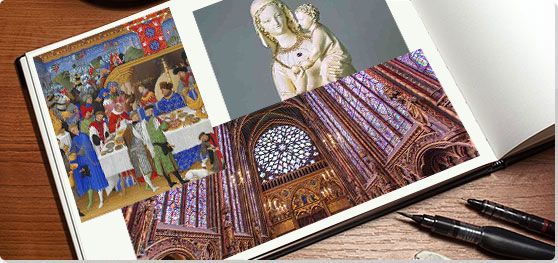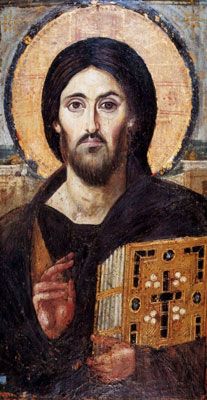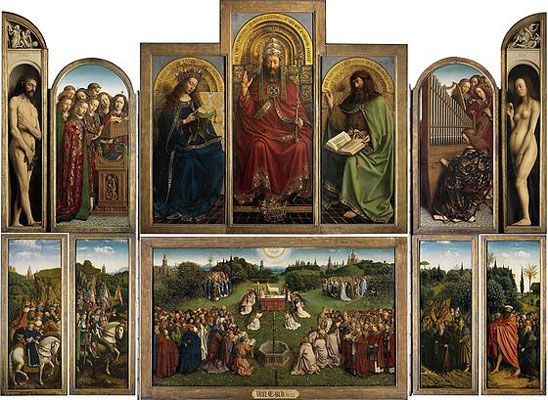Summary of Gothic Art and Architecture
With soaring vaults and resplendent stained glass windows, Gothic architecture attempted to recreate a heavenly environment on earth. Elaborating on Romanesque styles, Gothic builders, beginning in the 12th century, further developed the use of flying buttresses and decorative tracery between stained glass windows thus creating interior spaces that dwarfed worshippers and dazzled their senses. Additionally, in response to a new interest in humanism (manifested later and powerfully in Renaissance Humanism), architectural and portable sculpture primarily depicted figures that acquired more naturalistic and sensuous features than had previously existed in the Middle Ages. Wealthy noblemen commissioned sumptuous manuscript illuminations, and toward the end of the Gothic era in the 14th century, elaborate altarpieces and frescoes became more common in churches and chapels.
Renaissance artists and writers in the 16th century coined the term Gothic, and the early art historian Giorgio Vasari infamously reinforced the unfavorable connotations when he referred to Gothic art as “monstrous and barbaric” since it did not conform to classical ideals. It was not until the mid-1700s with the Gothic Revival in England that the style shed its negative associations. Subsequently Gothic architecture in particular inspired new churches in the 19th century, city buildings, and university architecture well into the 20th century.
Key Ideas & Accomplishments
- The innovations of Gothic architecture were premised on the ideas developed by Abbot Suger that earthly light contained divine light and that the physical edifice of the church needed to make this concept tangible. Revolutionary transformations of flying buttresses and groin vaulting allowed the inclusion of more stained glass windows in the church’s structure, thus transforming the everyday sunlight into a prism of colors that danced over the surfaces of the stone and reminded worshippers of God’s divine presence.
- A renewed interest in humanism, which had a slightly different cast than the later humanism of the Renaissance, led to more naturalistic figurative sculpture that decorated the exterior of the churches and housed sacred relics, which were increasingly important to a city’s reputation. In particular, representations of the Virgin Mary and Christ child move away from massive frontal poses to more typical, or everyday, poses that register the tender human emotion one often sees between mother and child.
- Combining aspects of Byzantine and Romanesque styles and even borrowing from Islamic architecture, Gothic art and architecture revel in its eclectic roots, growing and morphing to suit regional tastes and tendencies. By the end of the Middle Ages, the Gothic style had become “international” in its spread across Europe, and its emphasis on naturalism sparked the revolution in painting that flourished during the Renaissance even if its architecture was replaced with straighter lines and classical proportions.
Artworks and Artists of Gothic Art and Architecture
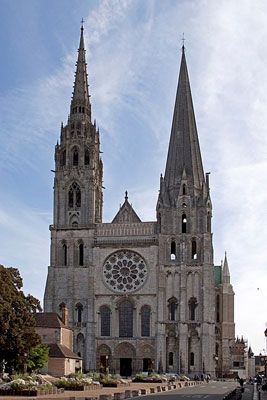
Cathédrale Notre-Dame de Chartres
Called “the high point of French Gothic art” by UNESCO, which designated Chartres cathedral a World Heritage Site, two spires dominate the Western façade; the spire on the right was completed about 1160, while the one on the left combines the original, lower tower with a spire in the Flamboyant style from the early 1500s. Together, the two towers create a dynamic vertical movement, echoed by the pointed arches of the openings and the three protruding columns ascending most of the length of the towers.
The cathedral is harmoniously composed of thirds, reflecting the Holy Trinity (Father, Son, and Holy Spirit); the three horizontal levels of the façade are clearly delineated, and three windows above the entrance echo the three portals. As a result, the cathedral powerfully conveys a sense of earthly power that is both grounded and soars upward.
The cathedral, situated on the tallest hill in the city of Chartres, dominates the view of the city, reflecting its importance not only as the center of religious life but also as a hub of economic and social life in its functions as a market place and a site for local fairs and festivals. As earlier buildings were destroyed in fires, the cathedral is the fifth church to be built on the site, a noted place of pilgrimage that was believed to house the Sancta Camisa, a garment that the Virgin Mary wore when she gave birth to Christ.
The rebuilding of this final cathedral that began in 1194, occurred in a relatively short period of time, and, as a result, the building has a remarkably cohesive style. Its innovations, including flying buttresses, three rose windows, many smaller stained glass windows, and the sculptural carvings around the portals, came to exemplify the Gothic style. Importantly, it has retained almost all of its original stained glass, a rarity for many churches. As the noted French author Victor Hugo wrote in the 1800s, cathedrals like Chartres belonged to “poetry and the people.”
Stone, stained glass - Chartres, France
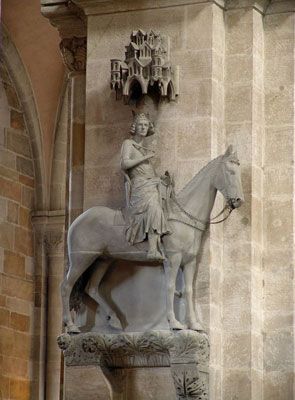
Bamberger Reiter
This stone sculpture known as the Bamberg Rider depicts a crowned but unarmed man, seated on a horse, turning to look at the viewer. A convincing naturalism, portraying the subject with realistic proportions and details, pervades the life-sized work, as the horse holds its head with the bit in its teeth, and its left, rear leg flexes as if restless. The man’s fashionable curls and dress indicate an aristocratic background, and his figure conveys a confident calmness as he surveys the distance, while tugging on a strap to draw his cloak around his shoulders. Scholars have debated the identity of the man, believing he may be a specific king known for saintly qualities, and several candidates have been suggested, from Saint Stephen I of Hungary to Emperor Henry II or Emperor Frederick II. Other scholars have argued that the figure may be Christ as depicted in the Book of Revelation, and the city rendered in stone framing the rider’s head as symbolic of heavenly Jerusalem. Originally the work was painted, though only traces remain.
The horse’s front hooves are resting on a depiction of the Green Man, carved into the base’s Acanthus corbel. A figure of pagan mythology, the Green Man or Wild Man was associated with fertility and here suggests the Christ-like horseman’s demonic but conquered counterpart. The overall effect of the work is of calm authority, as if the worshipper would be reminded of Christ the King and his promised reign as well as the Christ-like authority believed to be embodied in rulers. As art historian Shirin Fozi notes, “His calm gaze seems to suggest that, despite the realities of shifting ethnic identities and complex national boundaries, medieval Europe could still dream of a world united under the paradigm of a perfect Christian king.”
The life-sized work was remarkably innovative, being the first monumental equestrian statue since Roman times. The work has had a long cultural life in Germany, as the image was often displayed in public buildings, schools, and private homes. The mystery of the horseman’s identity enabled the work to become an often-evoked symbol, the meaning of the figure interpreted according to the cultural and political environment.
Stone - Bamberg Cathedral, Bamberg, Germany
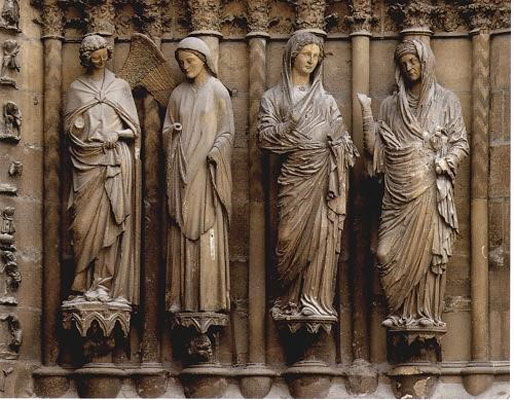
Annunciation and Visitation
This group of four figures found on the west portal of Reims Cathedral depicts the Annunciation and the Visitation of the Virgin Mary. The pair on the left depicts the smiling archangel Gabriel turning toward the Virgin Mary to tell her she will bear the son of God; Mary, who looks pensively downward, turns slightly toward the angel as if quietly listening. The Visitation, on the right, includes Mary, pregnant with Jesus, and her older cousin St. Elizabeth, pregnant with John the Baptist. Each of the figures conveys a sense of movement, as if they were engaged in conversation, their faces conveying subtle emotion, their draperies flowing realistically around them, and a touch of contrapposto can be seen, particularly in Elizabeth’s bent right knee.
The innovative figures are no longer emerging from pillars, as they were in the Romanesque and Early Gothic styles, but are fully realized sculptures, three-dimensional as if standing in front of the column-lined church. Because the work is anonymous like most Gothic era work, it’s not known if the same sculptor made all four figures, but the slender gracefulness of the two on the left compared with the more realistic depictions of the two on the right suggest that two different artists might be responsible. For worshippers of the day, they were convincingly life-like depictions of sacred figures, but as works of art the sculptures exemplify the High Gothic style while pointing the way to the later International Gothic style and the Renaissance.
Stone - Notre-Dame de Reims, Reims, France
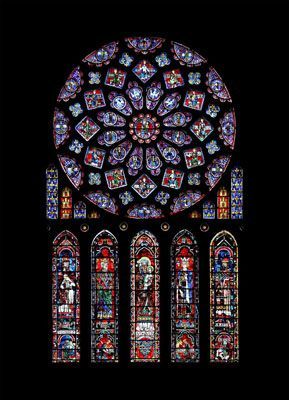
North Rose Window at Notre Dame Cathedral of Chartres
This iconic rose window, resplendent with rich color that makes it a masterwork of Gothic stained glass, depicts the Madonna and Child at its center. They are surrounded by twelve panels, radiating like the petals of a flower and depicting doves representing the gifts of the spirit and angels holding candles. In the next ring, 12 square windows placed at various angles show the Old Testament Kings of Judah, while small quatrefoils bear the fleur-de-lis, the symbol of France. The outer ring’s half circles show the Old Testament prophets, while just below the rose window, four lancet windows on either side carry the insignia of the kingdoms of France in blue and gold and of Castile in red and gold, noting the window’s patron, Queen Blanche of Castile. Five lancet windows below depict King Melchizedek, King David, the Virgin Mary as a child being held by St. Anne, her mother, in the center, and King Solomon and the high priest Aaron. These figures are portrayed as standing upon a defeated enemy; for instance, a vignette below King David’s feet depicts King Saul committing suicide.
As most worshippers were illiterate, stained glass windows played a didactic role, illustrating stories of the Bible and conveying moral meaning. Iconography played an important role in designing such windows, as the number 12, repeated here, symbolized the unity of the trinity times the number 4 representing mankind. The colors, too, were significant, as blue symbolized the Virgin Mary, whereas red symbolized the suffering and passion of Christ. Many of the church’s 176 windows used predominantly this distinctive shade of blue, named the “bleu de Chartres.” The rose was considered to be a symbol of perfect love as well as the “eye of God,” announcing God’s illuminating presence among men. The light, ever changing, radiated through the depths of the cathedral, creating an inspiring otherworldly effect, while the image reflected the sustaining presence of the Virgin Mary as comforting mother to Catholic worshippers of the era.
The windows of Chartres influenced the development of the Rayonnant style, which emphasized the rose window’s radial effect, exaggerating the petal-like shapes radiating from its center into “rays” of colored glass. The church has remained a continuing presence in the cultural imagination, as seen in filmmaker Orson Welles’ description in his film F for Fake (1973) as “this one anonymous glory of all things, this rich stone forest.” UNESCO described the cathedral as “a museum to stained glass.”
Stained glass - Chartres, France
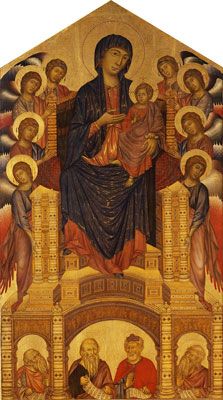
Maestà di Santa Trinita
Cimabue depicts the Madonna and Child enthroned in Heaven, seated upon an intricate gold throne that also suggests the architecture of Heaven, with its tower-like pillars. The two are flanked by angels, arranged symmetrically on either side, their hands holding the towers as if supporting them, while the faces of the first pair turn to the side, and the others above them turn toward the Virgin. Their wings create an overlapping pattern of color gradations illuminated by gold that both encloses and emphasizes the Madonna while leading the eye upward to her gaze at the apex of the triangle. Below, four prophets look out through a trio of arches, conveying the authority of tradition.
Cimabue’s innovations included moving painting away from Byzantine flat depictions and stylized figures, favoring instead more realistic proportions and shading, as seen in the naturalistic drapery of the Virgin’s clothing and the placement of her feet suggesting movement. A more naturalistic treatment of space is also evident, as seen in the two lower angels, whose placement shows that they are clearly standing behind the towers before them, as their figures take on an aspect of three-dimensionality. A noted teacher, Cimabue trained Pacino di Bonaguida and was said to have discovered Giotto. As art critic John Haber wrote of Cimabue, “In his grand, multi-tiered architecture and spare, wiry human forms, he could serve as the culmination of past ages or the beginning of the new.”
Tempera and gold foil on panel - Uffizi Gallery, Florence
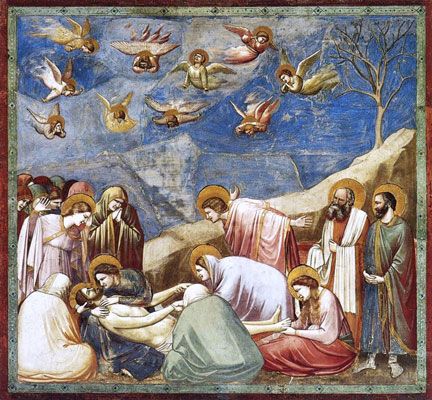
Lamentation (The Mourning of Christ)
This Late Gothic fresco depicts the mourning of Christ, as he is cradled by his mother who looks closely into his face, while Mary Magdalene holds his feet, and other shrouded mourners surround him. To the right, two apostles stand beside a stone wall that creates a diagonal that separates the human scene from the blue sky, where a multitude of angels flies, their wings and postures conveying divine distress. Other disciples stand at the left, one bending forward, the other with his face in his hands.
Giotto’s masterful composition keeps the viewer focused on the dead Christ’s face and the interaction between him and Mary while at the same time creating a radical sense of space in a rather shallow setting. Giotto depicts two disciples in the foreground with their backs to the viewer, and the central figures to the right with bent backs rise to the disciple who flings his arms behind him in a state of grief. He points to the group of mourners on the other side, unifying the crowd. The circular group of people emphasizes Christ’s horizontal body, and the radically foreshortened angels in the sky echo the earthly circular formation below.
The artist’s treatment of human emotion is realistic and powerful, as body language and facial expression convey both the outcry of anguish and the stolid presence of grief. This innovative sense of composition and a sculptural approach to the human figure, conveying gravity and weight, made Giotto’s work both the pinnacle of Late Gothic work and an important influence upon the Renaissance.
The very wealthy Enrico Scrovegni commissioned the fresco cycle in the Padua chapel to be his funerary monument and penance for his father’s usury, a sin in the Catholic church at the time. Giotto was thus funded and painted 37 scenes, arranged in three tiers, depicting the narrative of Christ’s life and the life of the Virgin, along with interspersed quatrefoil images of the Old Testament. Giovanni Villani, a chronicler of Giotto’s era, wrote that the artist was "the most sovereign master of painting in his time, who drew all his figures and their postures according to nature,” and in the 1500s Vasari described the artist as being a forerunner of the Renaissance, “introducing the technique of drawing accurately from life, which had been neglected for more than two hundred years.”
Fresco - Cappella degli Scrovegni, Padua, Italy
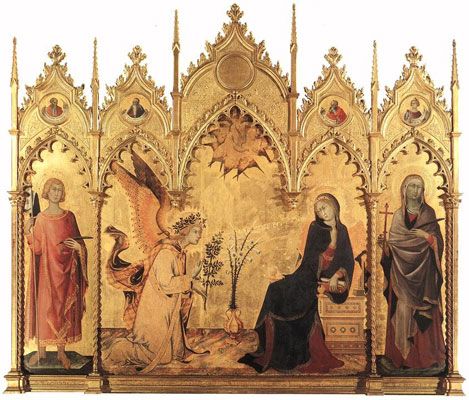
Annunciation with St. Margaret and St. Ansanus
The central panel depicts the Annunciation, when archangel Gabriel, carrying an olive branch, kneels before Mary, darkly robed on the right, and informs her that she will give birth to the son of God. Between them, a vase containing lilies, symbolizing purity, sits on the floor, while above in the central arch, a group of angels appears, their wings interlocking in a mandorla. The words “Hail, Mary, full of grace, the Lord is with thee” in Latin are embossed in gold, extending diagonally from the angel’s open lips toward Mary. Exquisite detailing, as seen in the angels’ wings and the decorative motif of the chair where Mary sits, give the work a sense of precise and elegant refinement.
The central panel is considered one of Martini’s masterworks, showing his innovative use of line combined with a sense of movement and human expression. The angel’s gown flares behind him as if he has just landed, and the Virgin seems to recoil, her face disbelieving at his announcement. Though the setting, employing extensive gold, and subject reflect Byzantine tradition, the portrayal of the Annunciation as a dramatic moment was unique in its time.
The prodigious use of gold leaf, lapis lazuli, and expensive lacquer, indicate the high status of this altarpiece, commissioned by the Cathedral of Siena, and dedicated to the city’s patron saints. Some scholars credit Lippo Memmi with the depiction of St. Margaret, on the far right, though other scholars also attribute to him the portrayals of St. Ansanus on the left and the prophets, Jeremiah, Ezekiel, Isaiah, and Daniel, in the tondos, or circular paintings. However, Memmi’s depictions lack the sophistication of Martini’s approach.
Tempera and gold leaf on wood - The Uffizi Gallery, Florence. Italy
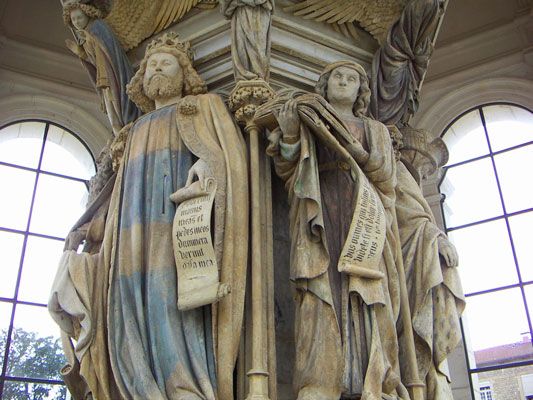
David and a prophet from the Well of Moses
In this view of the hexagonally shaped Well of Moses, one sees two of the six figures that surround the monumental edifice. The biblical King David, holding a scroll in his left hand, is visible at the left, while the Prophet Jeremiah, holding up a large book from which a scroll unfurls, is pictured on the right. Standing atop thin columns between the human figures, three angels are partially visible, their flaring wings creating the fount of the well. The fount was meant to convey not only the Well of Moses in Egypt but also the living water of the Christian faith, symbolized in baptism. A kind of sacred history is conveyed in the gathering of these figures, each connected to the word of God through the scrolls that he holds.
With its naturalistic human figures, powerfully conveying physical presence and individualized expressions, while denoting courtly elegance in the flowing rhythm of draperies and scrolls, this work innovatively exemplified the International Gothic Style. The Carthusian Monastery in Dijon commissioned the work from the artist who was the court artist for Phillip the Bold of Burgundy. The original structure was more complex, as the center of the well included a pier, carved with prophets and angels, and a cross rising from the depths to tower over the well, but only the well itself has survived. Originally the sculpture was painted and gilded by Jean Malouel, traces of which are visible in the blue bands of David’s robe and Jeremiah’s green sleeve, which would have created a more animated and lively effect. The sculptor has conveyed his subjects’ importance while also depicting their different personalities: David’s sense of strong but relaxed authority and Jeremiah’s pensiveness.
Sluter’s innovative three-dimensional and emotionally expressive figures had a noted influence upon Northern European Renaissance artists, including Rogier Van der Weyden, Matthias Grünewald, and Albrecht Dürer.
Stone, paint and gilding - Musée des Beaux-Arts de Dijon, Dijon, France
Beginnings of Gothic Art and Architecture
The Gothic Era
City-states and feudal kingdoms dotted Europe, and the power of the Catholic church continued to grow during the Gothic era. With increasing prosperity and more stable governments, cultural changes included the early formations of universities, like the University of Paris in 1150, and the proliferation of Catholic orders, like the Franciscan and Dominicans. The monks and theologians ushered in a new Humanism that sought to reconcile Platonic ideals and Church theology. The humanism at this time saw man as part of a complex hierarchy, divinely ordered by God whose ultimate nature surpassed reason.
Increasing trade led to the growth of many urban centers, and the local Cathedral became a sign of civic pride. At the same time, noble patronage began to play a primary role in building projects, as stained glass windows and portals emphasized the identification of the king as a kind of earthly representation of divine authority, as seen in the “royal portal” reserved for nobility and high ranking church officials. Some Gothic churches took decades to build, contributing both to the economy of the town and to the expansion of the necessary guilds that represented the various trades involved in construction and design. Most of the Early Gothic architects, sculptors, and designers of stained glass windows were anonymous, and it is only later in the High Gothic period that architects and artists known as “masters” became identified.
The architecture that informed the Gothic period drew upon a number of influences, including Romanesque, Byzantine, and Middle Eastern.
Romanesque
Romanesque churches from the 10th to the 12th centuries are noted for their use of barrel vaults, rounded arches, towers, and their thick walls, pillars and piers. Housing the relics of saints, the churches were part of the pilgrimage routes that extended throughout Europe, as the faithful visited the holy sites to seek forgiveness for their sins and attain the promise of Heaven.
Gothic architecture retained the Romanesque western façade as the entrance to the church with its two towers, three portals and sculptural works in the tympanum, a half circle area above the door, as well as its cruciform plan. While Gothic churches continued the religious tradition of the pilgrimage path, their new style reflected a new economic and political reality.
The Pointed Arch and Middle Eastern Architecture
The pointed arch was a noted element of Middle Eastern architecture beginning in the 7th century, as seen in the Al-Aqsa Mosque (780) in Jerusalem. Widely deployed in the building of mosques and palaces like the fortress of Al-Ukhaidir (775), the pointed arch was found throughout the Middle East, North Africa, Andalucia (modern day Spain), and Sicily. As architectural critic Jonathan Meades wrote, these early examples “would in the 12th century become the quintessential architecture of Christendom.” As the Pope and Catholic rulers sought to extend the range of Christianity in the Middle Ages through the Crusades, knowledge of Middle Eastern architecture became more common among Europeans.
The pointed arch made the Gothic style possible, as it could be used for asymmetrical spaces and to intersect columns at a sharp angle thus displacing the weight into the columns and lightening the walls. The structure also became key to a number of subsequent Gothic innovations, including the lancet arch, creating a high, narrow, and steeply pointed opening; the equilateral arch, widening the arch to allow for more circular forms in stained glass; and the flamboyant arch, primarily used in windows and traceries for decorative effect.
Flying Buttresses and Byzantine Architecture
The flying buttress was used in a few important and influential Byzantine structures. The buttress employed a massive column or pier, situated away from the building’s wall, and a “flyer,” an arch that, extending from the wall to the pier, displaced the weight-bearing load from the wall. The Basilica of San Vitale (547) in Ravenna, Italy, pioneered an early use of the flying buttress. The Basilica was famous for its mosaics and was a powerful symbol of the Byzantine Empire and the Roman Empire before it. As a result, it became a model for later architecture. The Emperor Charlemagne, who established the Holy Roman Empire in 799 and was dubbed “the father of Europe,” designed his Palatine Chapel in Aachen, Germany, after the Basilica of San Vitale.
Early Gothic: Basilica of Saint-Denis (1144)
The Basilica of Saint-Denis (1135-1144), near Paris, pioneered the Gothic style. Abbot Suger led the rebuilding of the church, a venerated site where Saint Denis was martyred and where almost every French monarch since the 7th century had been buried. A noted scholar, friend, and advisor to King Louis VI and then Louis VII, Suger was influenced by the works of Pseudo-Dionysius the Aeropagite, a 5th-6th century Christian philosopher and mystic. Pseudo-Dionysius believed that any aspect of earthly light was an aspect of divine light, a belief with which Suger concurred. Suger felt that the new Gothic style would lift up the soul to God. His design envisioned a soaring verticality, and key to this was the use of the pointed arch that allowed for a vaulted ceiling and thinner walls that could contain numerous stained glass windows. The Church of Saint-Denis became the model for the Gothic style of architecture, spreading throughout Europe.
Following on and expanding the Romanesque practice, Early Gothic churches also employed sculpture to decorate the building. Religious scenes were carved into the tympanum over the doorways, and the surrounding archivolts and lintels were filled with figures. Secular images were also created, as the Basilica of St. Denis had the signs of the zodiac carved into the sides of the left portal and scenes depicting the agricultural labors of the month on the right. Most noted were the various column statues, depicting Old Testament Kings and Prophets on the portal columns.
High Gothic (1200-80)
Beginning around 1200, the High Gothic period developed toward ever-greater verticality by including pinnacles, spires, and emphasizing both the structural and decorative effect of flying buttresses. The rose window was expanded in size, and the tracery, the intervening metal bars between sections of stained glass, was elaborated for decorative effect. Chartres Cathedral (1194-1420), Amiens Cathedral (1220-1269), and Notre Dame de Paris (1163-1345) were all notable examples of High Gothic. The High Gothic period was also marked by the development of two distinct sub styles: the Rayonnant and the Flamboyant. Most Late Gothic architecture employed the Flamboyant Style, which continued into the 1500s.
High Gothic churches continued to use sculptures, particularly around the portals, but figurative treatments became more naturalistic, as the figures stepped free of the columns that once contained them. Smaller, portable sculptures, like The Virgin and Child from the Sainte-Chappelle (c. 1260-1270), became popular. The small work, though elegant and stylized, is naturalistically sculpted, depicting the s-curve of movement and the realistic flow of draperies.
International Gothic
The International Gothic style is the term used for the courtly decorative style of illuminated manuscripts, tapestries, painting, and sculpture that developed around 1375. The style, associated with European courts, has also been called “the beautiful style,” for its emphasis on elegance, delicate detail, soft facial expressions, and smooth forms. The Holy Roman Emperor Charles IV in Prague, the Valois King of France, and the Visconti of Milan were the most important patrons and competed with each other to create a cultural capital that would attract leading artists. The portability of many of the works created, as well as the system of patronage that led artists to travel to different courts, spread the style’s influence throughout Europe.
Gothic Art and Architecture: Concepts, Styles, and Trends
The most important developments in later Gothic architecture were the Rayonnant Style followed by the Flamboyant Style. In painting, the most significant singular style was that of the Italian Sienese School, and the illuminated manuscript painting of the International Gothic Style.
Rayonnant Style (1240-1350)
Rayonnant is a term used to describe the style of French High Gothic architecture. Architects began to emphasize repetitive decorative motifs, a smaller, more human-scaled building, and a plethora of stained glass. The radiating “rays” of light that streamed through the glass gave the movement its name. Gothic architect Hugues Libergier first began developing the style in the Abbey church of Saint Nicaise in Reims, France around 1231. Little is known about the architect, except his name and that after his death in 1263 he was buried in the church where his tombstone honored him as a master of architecture. His innovations included a façade that used point gables and emphasized tracery, the molding between small sections of color glass, to create a kind of screen-like effect.
A famous early example of the Rayonnant style was Sainte-Chappelle (1242-1248) in Paris. Commissioned by the French King Louis IX to hold his numerous holy relics, most notably the Crown of Thorns, the chapel was also a symbol of royal prestige. Its fifteen large windows created a sense of soaring verticality and lightness, as wall space was almost eliminated and replaced by resplendent images and thin golden ribs. Designed by Pierre de Montreuil, who was dubbed “the Master of Sainte-Chappelle,” the chapel became the model for similar royal chapels throughout France and Europe. Louis IX played a noted role in promoting the style, which was employed in various noted cathedrals including Bernard de Soissons’ design of Reims Cathedral (c. 1250), the Church of St. Urbain (1262-1286) in Troyes, France, as well as the high choir of Cologne Cathedral in Germany, which was begun in 1248.
As was characteristic in the Gothic era, the Rayonnant style took on regional variations. In England, the style was called the English Decorated Style and emphasized window tracery, as stained glass windows were subdivided into many small parallel panels, and then at the top of the arch broke into curving and branching trefoil and quatrefoil shapes.
Flamboyant Style (1350-1550)
The French Flamboyant style, developing from the Rayonnant style, emphasized even greater decorative effects by employing more curved shapes. The name comes from the French word “flambé” meaning flame, as the curving ornate lines of edifices were thought to resemble flames. The overall effect was a dynamic and exuberant movement. It’s thought by some scholars that the intricate patterns and motifs from illuminated manuscripts were a noted influence.
Amboise Havel’s design for the western façade of the Church of St. Maclou (1436-1521) in Rouen, France, was a noted example of the style employed in religious architecture; however, it was also used for royal commissions, like Guy de Dammartin’s design for the Palace of the Duc de Berry, Poitiers (1386), and other private residences like the Hôtel de Cluny, Paris (1485-98). In England, the style was known as the Perpendicular Style, where it was championed by William Ramsey and John Sponlee, the royal architects, and in Germany the style was known as Sondergotik, or special Gothic.
The Sienese School (1250-1500)
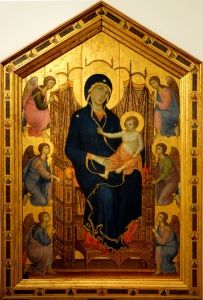
The Sienese School, influenced by the developing interest in Humanist ideals among Franciscan and Dominican friars, was the primary force in developing an innovative style of Gothic painting. Coppo di Marcovaldo and Guido da Siena started the School around 1250, though the most noted early leader of the school was Duccio di Buoninsegna, known commonly as Duccio. Dubbed “the father of Sienese painting,” he combined Byzantine gold backgrounds and religious iconography with a new interest in modeling the human form. Painted primarily in tempera on wood, his works included delicate details, elements of human emotion, and architectural settings, while also conveying an elegant otherworldly effect, as seen in his Rucellai Madonna (1285). A noted teacher, Duccio trained and influenced Simone Martini, the subsequent leading painter of the Sienese School, as well as the brothers Pietro and Ambrogio Lorenzetti. Martini’s works, employing an elegant sense of line and refined decorative effect, as seen in his Maestà (1315), influenced the International Gothic Style.
Illuminated Manuscripts
Illuminated manuscripts, combining religious texts with painted illustrations, became a noted feature of the International Gothic style, centered around the University of Paris. Influenced by Simone Martini of the Sienese School and by Giotto and Duccio’s work that he had encountered on a trip to Italy, Jean Pucelle’s Belleville Breviary (1326) and his acclaimed Hours of Jeanne d’Evreux (1324-28) exemplified the style. Pucelle’s naturalistic treatment included three-dimensional space, sculptural modeling of the human figure, and precisely observed details.
The royal courts in Bourges and Paris commissioned many small prayer books, called Books of Hours. Though centered in France, many of the artists were from the Netherlands, where they had been trained in the painting of miniatures, and included Jacquemart de Hesdin, Jean Pucelle, the artist known as “The Bourcicaut Master,” and the Limbourg brothers. The Limbourg brothers’ Les Tres Riches Heures du Duc de Berry (1412-1416) became the most famous masterpiece of the International Gothic style. A vivid color palette and realistic scenes of ordinary life marked the Tres Riches Heures, celebrating secular life as much as fulfilling a religious purpose.
Later Developments - After Gothic Art and Architecture
The Gothic era in general ended with the rise of the Renaissance, but its end was not uniform, as architecture continued to occasionally use the style, as seen in King Henry VII’s Chapel, built in the early 1500s, and the Gothic Basilica of San Patronino in Bologna, Italy, completed in 1658. In painting, the works of Giotto had a noted influence on both Italian Renaissance painters, including Masaccio and Michelangelo, and Northern European illuminated manuscripts and printmaking. Sculptors like Claus Sluter influenced artists of the Northern European Renaissance including Roger Van der Weyden and Albrecht Dürer.
During the Romantic era, artists began to value the medieval arts and picturesque ruins, and the Gothic style saw a revival. Known as the Neo-Gothic, the revival began in England in the mid-1700s, and Horace Walpole’s Strawberry Hill House (1749) near London is a noted early example. The style spread throughout England and its colonies, as well as the United States. As art historian Kenneth Clark wrote of the Gothic Revival, “It changed the face of England, building and restoring churches all over the countryside, and filling our towns with Gothic banks and grocers, Gothic lodging houses and insurance companies, Gothic everything from a town hall to a slum public house.” Subsequently, Gothic art and architecture influenced both the Pre-Raphaelite Brotherhood and the Arts and Crafts movement, as medieval values and craftsmanship were seen as a positive antidote to the industrialism of the 1800s. The ideas of noted architect A.W. N. Pugin, who designed the interior of Westminster Palace (1840-1876) and the art critic John Ruskin made the Gothic Revival style dominant in the Victorian era.
In France, the government commissioned the noted architect Eugène Viollet-le-Duc to evaluate the condition of pre-existent Gothic buildings, which led to his restoring and also completing a number of French Gothic cathedrals in the 1840s. New churches in the Neo-Gothic style were also built like Saint Clotilde Basilica (1857) in Paris.
Ever since the Gothic Revival, contemporary architecture continues to draw upon the Gothic style, as elements of the design are incorporated into modern buildings or their renovations, as in the Hof van Busleyden (2013), the Market Hall in Ghent (2011-2012), both in Belgium, and Drents Archief (2010-2012) in The Netherlands.
Useful Resources on Gothic Art and Architecture
-
![A White Garment of Churches: Romanesque and Gothic Art]() 39k viewsA White Garment of Churches: Romanesque and Gothic ArtOur PickWith Michael Wood
39k viewsA White Garment of Churches: Romanesque and Gothic ArtOur PickWith Michael Wood -
![Engineering the Impossible: Chartres Cathedral]() 242k viewsEngineering the Impossible: Chartres CathedralOur PickNational Geographic
242k viewsEngineering the Impossible: Chartres CathedralOur PickNational Geographic -
![Landmarks of Western Art Documentary. Episode 01 The Late Medieval World]() 144k viewsLandmarks of Western Art Documentary. Episode 01 The Late Medieval WorldArtandFilm21
144k viewsLandmarks of Western Art Documentary. Episode 01 The Late Medieval WorldArtandFilm21 -
![Architects of the Divine: The First Gothic Age]() 16k viewsArchitects of the Divine: The First Gothic AgeArtDocumentaries
16k viewsArchitects of the Divine: The First Gothic AgeArtDocumentaries
